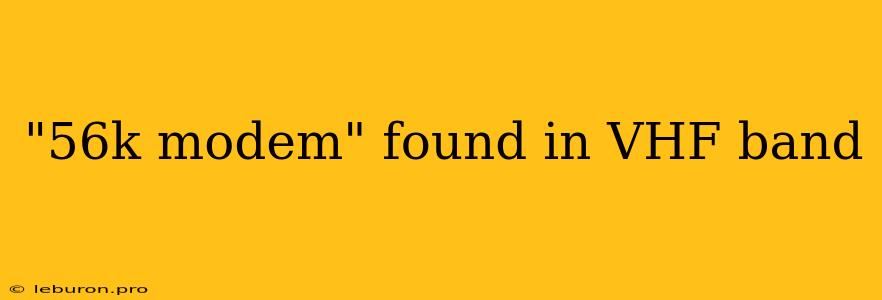The world of internet connectivity has evolved significantly since the days of dial-up, but the legacy of the 56k modem still lingers in the collective memory of those who experienced the internet in its nascent stages. While we now enjoy the blazing speeds of fiber optic and 5G, it's fascinating to look back at the technology that laid the groundwork for today's digital landscape. One aspect that often sparks curiosity is the connection between the 56k modem and the Very High Frequency (VHF) band, a seemingly unexpected link. This article delves into the workings of the 56k modem and explores its relationship with the VHF band, shedding light on the technical details and historical context.
The Essence of the 56k Modem
The 56k modem, a technological marvel for its time, revolutionized personal computer connectivity to the internet. Its name is a testament to its potential speed, capable of transferring data at a maximum rate of 56,000 bits per second. This was a significant leap from the previous generation of modems, which typically operated at speeds of 28.8kbps or slower. The 56k modem employed a clever combination of modulation techniques and data compression algorithms to achieve these impressive speeds.
How the 56k Modem Worked
At the heart of the 56k modem was a complex interplay of analog and digital signals. It converted digital data from the computer into analog signals that could be transmitted over traditional phone lines. This process involved two key components:
- Modulation: The modem used a technique called Quadrature Amplitude Modulation (QAM) to encode digital data onto analog carrier waves. QAM allows for multiple data bits to be represented by different combinations of amplitude and phase shifts in the carrier wave, thus increasing the efficiency of transmission.
- Compression: The 56k modem incorporated data compression algorithms to reduce the volume of data transmitted, further enhancing its speed. These algorithms worked by identifying recurring patterns in the data stream and replacing them with shorter codes.
The VHF Band and its Role in the 56k Modem
The 56k modem operated within the frequency range of the Public Switched Telephone Network (PSTN), which utilized the VHF band for its communication. This means that the analog signals generated by the modem, after being modulated and compressed, traveled through phone lines that were part of the VHF spectrum.
VHF Bandwidth and 56k Modem Limits
The VHF band, though suitable for voice communication, posed limitations on the speed of the 56k modem. The available bandwidth within this band was not sufficient to support the full theoretical speed of 56kbps. In practice, actual transmission speeds rarely reached the advertised 56kbps, often falling to lower speeds like 33.6kbps or 44.1kbps depending on line quality and other factors.
Signal Attenuation and Noise
Another constraint imposed by the VHF band was signal attenuation and noise. As signals traveled through phone lines, their strength gradually diminished, especially over long distances. Furthermore, electrical noise from other sources could interfere with the transmission, further degrading the signal quality. These factors contributed to the inconsistencies in transmission speeds and sometimes resulted in dropped connections.
The Legacy of the 56k Modem and the VHF Band
The 56k modem and its relationship with the VHF band represent a significant chapter in the history of internet connectivity. While today's broadband speeds have rendered the 56k modem obsolete, it played a pivotal role in democratizing internet access and laying the foundation for the digital world we know today.
The Impact of the 56k Modem
The 56k modem ushered in an era of widespread internet adoption. It enabled individuals and businesses to connect to the internet from their homes and offices, fostering the growth of online communities, e-commerce, and digital communication. The 56k modem also paved the way for the development of faster technologies, like DSL and cable modems, which further accelerated internet accessibility.
The VHF Band and Beyond
While the VHF band served as the platform for the 56k modem, the evolution of internet technologies moved towards higher frequency bands. Technologies like DSL and cable modems utilize the higher frequency bands, offering significantly greater bandwidth and faster transmission speeds. This shift away from the VHF band reflects the constant progress in internet connectivity, driven by the need for higher bandwidth and faster speeds to meet the demands of a digitally connected world.
Conclusion
The story of the 56k modem is one of technological innovation, overcoming limitations, and laying the groundwork for the future. Its reliance on the VHF band, while offering a platform for internet access, ultimately highlighted the limitations of this frequency range. The evolution of internet technologies moved beyond the VHF band, embracing higher frequency bands to deliver faster speeds and greater bandwidth. The legacy of the 56k modem reminds us of the remarkable progress in internet connectivity and the enduring power of innovation to overcome technological constraints. Today, we benefit from the advancements that were born out of the limitations of the 56k modem and the VHF band, enjoying a digital world that is faster, more connected, and more accessible than ever before.
